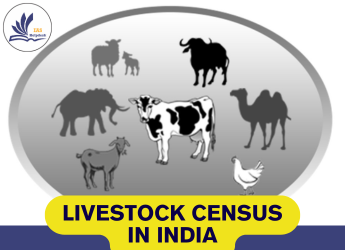Livestock Census in India: A Comprehensive Overview
Description
Livestock Census in India: A Comprehensive Overview
The Livestock
Census in India is a critical tool for gathering data on domesticated animals,
their breeds, and their roles in the economy. Conducted by the Department of
Animal Husbandry and Dairying, the census is held every five years and provides
essential insights into India’s livestock sector. Here’s a breakdown of what
this extensive survey entails and how it impacts the country's economy and
agricultural policies.
What is the Livestock Census All About?
The Livestock
Census is a large-scale data collection effort conducted every five years,
which counts the number of domesticated animals, poultry, and stray animals
across India. The data includes information on species, breed, age, sex, and
ownership, providing a detailed view of the country's animal resources.
Initiated in 1919, India has completed 20 such censuses to date, with the 21st
census scheduled for October 2024 to February 2025.
How is the Livestock Census Conducted?
Approximately
87,000 enumerators are set to visit each independent household, apartment,
enterprise, and institution, such as gaushalas (cattle sheds), dairy farms,
poultry farms, veterinary colleges, and defense establishments. This process,
spanning five months, aims to cover around 30 crore households across India,
collecting essential data that informs national policy and economic planning.
Which Animals Will Be Counted in the 21st
Census?
The upcoming 21st
Livestock Census will gather data on sixteen animal species, including:
- Cattle
- Buffalo
- Mithun
- Yak
- Sheep
- Goat
- Pig
- Camel
- Horse
- Ponies
- Mule
- Donkey
- Dog
- Rabbit
- Elephant
In total, 219
indigenous breeds of these species, recognized by the ICAR-National Bureau of
Animal Genetic Resources (NBAGR), will be enumerated. Additionally, poultry
birds such as fowl, chicken, duck, turkey, geese, quail, ostrich, and emu will
also be counted.
Objectives of the Livestock Census
The primary
objective of the Livestock Census is to capture data on the population, breeds,
and socio-economic role of animals across the country. This data provides
valuable insights into India’s agricultural and economic landscape:
- Economic
Contribution:
The livestock sector is vital for rural employment and contributes about
4.7% to India's Gross Value Added (GVA), while the agriculture sector
overall contributes approximately 15%. Poultry and animal husbandry alone
account for around 30% of the agricultural GVA, emphasizing the importance
of this sector.
- Policy
Formulation and Implementation: The data from the census aids the
government in devising policies to promote sustainable growth in the
livestock sector. Union Minister Singh emphasized the census’s role in
shaping policies to support the sector’s expansion and sustainability.
- Tracking
Sustainable Development Goals (SDGs): The census will contribute to
India’s progress towards achieving the United Nations Sustainable
Development Goals, specifically Goal 2 (Zero Hunger) and Target 2.5
(genetic diversity in food). Indicator 2.5.2 of the SDGs tracks the
percentage of local livestock breeds at risk of extinction, which the
census data will help assess.
How Will the 21st Livestock Census Differ from
Previous Ones?
The 21st
Livestock Census will employ advanced digital tools, similar to the 2019
census. Key innovations include:
- Fully
Digitised Process:
Online data collection will be conducted through a mobile application,
ensuring accuracy and efficiency. A digital dashboard will monitor data
collection in real time, with each data point marked by location
coordinates (latitude and longitude).
- Enhanced
Data Points:
New data points will capture the socio-economic status of pastoralists and
their contributions to the livestock sector. The census will also document
the proportion of households reliant on livestock for their primary income
and gather gender-specific data on stray cattle.
What did the 2019 Livestock Census find?
535.78 million was the total livestock population. This included:
·
192.9 million cattle
·
148.88 million goats
·
109.85 million buffaloes
·
74.26 million sheep
·
9.06 million pigs
All other animals taken together contributed just 0.23% of the
total livestock population in India.
Importance of the Livestock Census for India's
Future
The comprehensive
data provided by the Livestock Census holds significant implications for
India’s rural economy and sustainable development goals. The data will guide resource
allocation, help improve animal healthcare services, and support the
development of livestock-based rural industries. The census will also help
India ensure food security, improve livelihoods, and sustain genetic diversity
within the livestock sector.
In conclusion,
the 21st Livestock Census marks an important step in modernizing and refining
the process of data collection in India’s animal husbandry sector. The insights
it will offer are invaluable for policymakers, researchers, and stakeholders,
fostering informed decisions that will drive growth, sustainability, and
prosperity in rural India.

